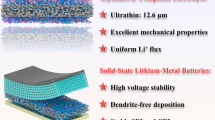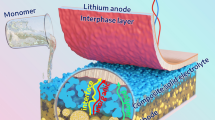Abstract
Iron difluoride (FeF2) is considered a high-capacity cathode material for lithium-ion batteries. However, its specific capacity and stability are limited by the poor electrochemical kinetics of conversion reactions. Herein, the conversion reaction is confined in a localized nanosized space by encapsulating FeF2 nanoparticles in polymer gelatin. The FeF2 nanocrystal-coated polyvinylidene fluoride-based layer (defined as FeF2@100%G-40%P) was synthesized by glucose-assisted in-situ gelatinization to construct an artificial cathode solid electrolyte interphase via a solvothermal process. Thanks to the improved kinetics of the localized conversion reaction, the obtained FeF2@100%G-40%P electrodes show good cyclic stability (313 mA h g−1 after 150 cycles at 100 mA g−1, corresponding to a retention of 80%) and a high rate performance (186.6 mA h g−1 at 500 mA g−1).

摘要
氟化亚铁被认为是锂离子电池的高容量正极材料. 然而, 由于转换反应的电化学动力学不佳, 它们的比容量和稳定性受到很大限制. 如果将转换反应限域在纳米空间中, 可有效避免由于活性物质的长大而导致的失活. 本文中, 我们通过葡萄糖还原和聚偏氟乙烯原位包覆的方法, 在FeF2纳米晶体表面构建了一层聚偏氟乙烯基人工正极固体电解质膜(CEI)(材料定义为FeF2@100%G-40%P). 由于纳米限域空间改善了转化反应的动力学, 抑制了纳米晶长大, 所获得的FeF2@100%G-40%P电 极显示出良好的循环稳定性(在100 mA g−1的电流密度下, 循环150次比容量为313 mA h g−1, 容量保持率为80%)和高倍率性能(在500mA g−1的电流密度下, 比容量为186.6 mA h g−1).
Similar content being viewed by others
References
Armand M, Tarascon JM. Building better batteries. Nature, 2008, 451: 652–657
Larcher D, Tarascon JM. Towards greener and more sustainable batteries for electrical energy storage. Nat Chem, 2015, 7: 19–29
Zhou L, Yao L, Li S, et al. The combination of intercalation and conversion reactions to improve the volumetric capacity of the cathode in Li-S batteries. J Mater Chem A, 2019, 7: 3618–3623
He J, Chen Y, Lv W, et al. Three-dimensional hierarchical graphene-CNT@Se: A highly efficient freestanding cathode for Li-Se batteries. ACS Energy Lett, 2016, 1: 16–20
Wang F, Kim SW, Seo DH, et al. Ternary metal fluorides as high-energy cathodes with low cycling hysteresis. Nat Commun, 2015, 6: 6668
Wu F, Yushin G. Conversion cathodes for rechargeable lithium and lithium-ion batteries. Energy Environ Sci, 2017, 10: 435–459
Gordon D, Huang Q, Magasinski A, et al. Mixed metal difluorides as high capacity conversion-type cathodes: Impact of composition on stability and performance. Adv Energy Mater, 2018, 8: 1800213
Wang X, Gu W, Lee JT, et al. Carbon nanotube-CoF2 multifunctional cathode for lithium ion batteries: Effect of electrolyte on cycle stability. Small, 2015, 11: 5164–5173
Badway F, Mansour AN, Pereira N, et al. Structure and electrochemistry of copper fluoride nanocomposites utilizing mixed conducting matrices. Chem Mater, 2007, 19: 4129–4141
Schütte K, Barthel J, Endres M, et al. Synthesis of metal nanoparticles and metal fluoride nanoparticles from metal amidinate precursors in 1-butyl-3-methylimidazolium ionic liquids and propylene carbonate. ChemistryOpen, 2017, 6: 137–148
Badway F, Cosandey F, Pereira N, et al. Carbon metal fluoride nanocomposites. J Electrochem Soc, 2003, 150: A1318
Prakash R, Mishra AK, Roth A, et al. A ferrocene-based carbon-iron lithium fluoride nanocomposite as a stable electrode material in lithium batteries. J Mater Chem, 2010, 20: 1871–1876
Zhou J, Zhang D, Zhang X, et al. Carbon-nanotube-encapsulated FeF2 nanorods for high-performance lithium-ion cathode materials. ACS Appl Mater Interfaces, 2014, 6: 21223–21229
Zhang Y, Wang L, Li J, et al. A one-pot approach towards FeF2-carbon core-shell composite and its application in lithium ion batteries. J Alloys Compd, 2014, 606: 226–230
Reddy MA, Breitung B, Chakravadhanula VSK, et al. CFx derived carbon-FeF2 nanocomposites for reversible lithium storage. Adv Energy Mater, 2013, 3: 308–313
Huang Q, Turcheniuk K, Ren X, et al. Insights into the effects of electrolyte composition on the performance and stability of FeF2 conversion-type cathodes. Adv Energy Mater, 2019, 9: 1803323
Gu W, Borodin O, Zdyrko B, et al. Lithium-iron fluoride battery with in situ surface protection. Adv Funct Mater, 2016, 26: 1507–1516
Xiao AW, Lee HJ, Capone I, et al. Understanding the conversion mechanism and performance of monodisperse FeF2 nanocrystal cathodes. Nat Mater, 2020, 19: 644–654
Wu S, Su B, Ni K, et al. Fluorinated carbonate electrolyte with superior oxidative stability enables long-term cycle stability of Na2/3Ni1/3Mn2/3O2 cathodes in sodium-ion batteries. Adv Energy Mater, 2021, 11: 2002737
Huang Q, Turcheniuk K, Ren X, et al. Cycle stability of conversion-type iron fluoride lithium battery cathode at elevated temperatures in polymer electrolyte composites. Nat Mater, 2019, 18: 1343–1349
Ding J, Zhou X, Wang H, et al. Mn-doped Fe1−xMnxF3·0.33H2O/C cathodes for Li-ion batteries: First-principles calculations and experimental study. ACS Appl Mater Interfaces, 2019, 11: 3852–3860
Wei S, Wang X, Yu R, et al. Ti-doped Fe1−xTixF3·0.33H2O/C nanocomposite as an ultrahigh rate capability cathode materials of lithium ion batteries. J Alloys Compd, 2017, 702: 372–380
Sun H, Zhou H, Xu Z, et al. Preparation of anhydrous iron fluoride with porous fusiform structure and its application for Li-ion batteries. Microporous Mesoporous Mater, 2017, 253: 10–17
Wang Y, Zhao J, Zhu Y, et al. Controlled fabrication and optical properties of 3D hierarchical α-Bi2O3 siamesed microflowers. Colloids Surfs A-Physicochem Eng Aspects, 2013, 434: 296–302
Rajati H, Navarchian AH, Tangestaninejad S. Preparation and characterization of mixed matrix membranes based on matrimid/PVDF blend and MIL-101(Cr) as filler for CO2/CH4 separation. Chem Eng Sci, 2018, 185: 92–104
Kayal S, Sun B, Chakraborty A. Study of metal-organic framework MIL-101(Cr) for natural gas (methane) storage and compare with other MOFs (metal-organic frameworks). Energy, 2015, 91: 772–781
Zak AK, Gan WC, Majid WHA, et al. Experimental and theoretical dielectric studies of PVDF/PZT nanocomposite thin films. Ceramics Int, 2011, 37: 1653–1660
Acknowledgements
This work was supported by the Science and Technology Commission of Shanghai Municipality (20520710400, 19JC1412600 and 18230743400), the National Natural Science Foundation of China (21771124 and 21901156), the Oceanic Interdisciplinary Program (SL2020MS020), and the SJTU-Warwick Joint Seed Fund (2019/20) of Shanghai Jiao Tong University.
Author information
Authors and Affiliations
Contributions
Author contributions Chen M designed and engineered the materials; Zhao L characterized the battery performances; Zhao L, Li X and Liu X contributed to the data analyses and discussion; Chen M wrote the paper with support from Zai J, Qi R, and Qian X. All authors contributed to the general discussion.
Corresponding authors
Additional information
Conflict of interest
The authors declare that they have no conflict of interest.
Ming Chen received his BE degree in 2014 from Jiujiang University and ME degree in 2018 from Shanghai Normal University. He is a PhD candidate at the School of Chemistry and Chemical Engineering, Shanghai Jiao Tong University. His research interests mainly focus on lithium-ion batteries.
Jiantao Zai received his bachelor (2007) and PhD (2012) degrees in applied chemistry from Shanghai Jiao Tong University, then worked with Prof. Donghai Wang at Penn State University. He joined Shanghai Jiao Tong University as a lecturer in 2014. His research interests include the synthesis chemistry of group IV inorganic materials and their potential applications in energy storage, photovoltaic and photocatalytic areas.
Rongrong Qi received her bachelor degree from Hefei University of Technology, master and PhD degrees from the University of Science and Technology of China. Her research interests include polymers and inorganic nanocomposites.
Xuefeng Qian is a professor and vice dean of the School of Chemistry and Chemical Engineering and a faculty at the State Key Laboratory of Metal Matrix Composites, Shanghai Jiao Tong University. His research interests include structure design, controlled synthesis, modification, and applications of nanomaterials in energy storage and solar energy utilization. He received his bachelor degree in polymer material science (1990) from Hefei University of Technology, master degree (1995) in polymer material science and PhD degree (1998) in inorganic chemistry from the University of Science and Technology of China.
Supporting Information
Rights and permissions
About this article
Cite this article
Chen, M., Zhao, L., Li, X. et al. Artificial cathode solid electrolyte interphase to endow highly stable lithium storage of FeF2 nanocrystals. Sci. China Mater. 65, 629–636 (2022). https://doi.org/10.1007/s40843-021-1773-8
Received:
Accepted:
Published:
Issue Date:
DOI: https://doi.org/10.1007/s40843-021-1773-8




